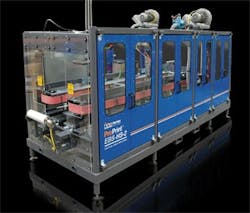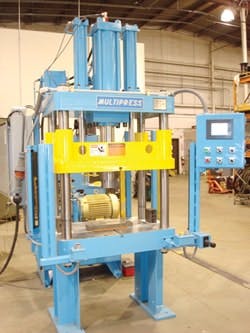A key component of improved manufacturing will be better machines and robots, but the definition of "better" is changing before our eyes as production requirements and needs evolve. Performance indicators of the past such as high throughput and low upfront costs are being replaced by new primary objectives such as flexibility and low lifecycle costs.
Bend, but Don't Break
Perhaps the most important machine automation trend is flexible production. Machines need to be reconfigured on the fly to produce different products, and this flexibility must be supplied with ease-of-use.
"We see full or partially automated changeovers as a key trend for our machines and their automation systems," says Dave Zurlinden, president of Pro Pack Systems in Salinas, Calif. Pro Pack makes fully automatic packaging machines and systems including case printer/erector/bottom sealers, case packers and case sealers (Figure 1). Its emphasis is in secondary packaging where corrugated shipping cases are used for cartoned, bottled and bagged products in the food and beverage markets.
We implement changeovers via recipe storage and retrieval from the HMI," relates Zurlinden. "An operator simply selects the desired recipe at changeover, which commands servos to automatically resize the machine to the next case recipe. The obvious benefit is dramatically reduced changeover time," says Zurlinden. "But the not-so-obvious benefit is repeatability in the changeover process via the elimination of human-induced setup errors."
Once a recipe is tuned in and programmed into the system, subsequent production runs won't need manual setup or production tuning time. "Recipe-based production improves repeatability, and recipe-driven human interfaces enable less-skilled operators to run machines," notes Michael Gurney, principal at Concept Systems in Albany, Ore.
Pro Pack Systems builds fully automatic high-speed machines used to print and set up corrugated shipping containers prior to packing. They feature a recipe-driven servo-controlled changeover system to automatically reset machine parameters when case sizes change, speeding changeover time and eliminating setup errors.
Source: PRO PACK SYSTEMS
Flexible production requirements also affect robot builders. "Shifting consumer demands are driving more flexible automation processes," observes Ted Wodoslawsky, vice president of marketing at ABB Robotics. ABB manufactures four and six-axis articulated robots (Figure 2) and a high-speed, four-axis delta robot.
"Take for example a cookie manufacturer making product for both branded and generic markets," explains Wodoslawsky. "The branded cookies come six or 12 in a package, regardless of the raw material cost. The count of the number of cookies in the generic package varies with the raw material costs. The cookie manufacturer needs the ability to change his pack count quickly to serve both market segments, and robotic automation provides the answer."
Automation provides flexibility, especially when it is delivered in software rather than hardware. "More flexible software and hardware automation platforms allow machines to be reconfigured or upgraded," observes Lee Hilpert, president of system integrator HilTech Engineering in Tomball, Texas. "Newer automation products become much more flexible, especially on the communication side. On one of our projects, the end user continues to find new ways to apply the control system in ways never anticipated during initial development. Flexible automation has allowed us to reconfigure communications and functionality without new hardware even though the application is completely different."
ABB designs robots for packing applications. It combines extended reach with high payload capacity, and it's small enough to fit into compact packing machines. Combined with motion control systems and tracking hardware, the robot can be used in flexible packaging systems.
Source: ABB ROBOTICS
Where Are All the Workers?
Despite the current relatively high rate of unemployment, it's still difficult and expensive to find and retain highly skilled manufacturing employees. Because skilled factory labor is such a valuable and rare commodity, a powerful long-term trend is to augment labor with automation.
This takes on a number of forms. Automation is used to make machines easier to operate and maintain. Automation is used to replace labor, in the process often improving the quality of the end product. Finally, automation is used to make machines safer to operate, protecting valuable factory workers from harm.
Ease-of-use through intelligent automation is a trend that's here to stay. "With intelligent design, automation can be used to make the human interface to machines more efficient," explains Pro Pack's Zurlinden. "HMIs and PLCs can provide maintenance reminders and include signoffs to indicate when work is done. PLC programming can include predictive maintenance based on actual machine use and other measured parameters."
So ease-of-use is now a key value in machine design compared to a decade ago when the focus was on throughput. "As technology advances, the machine-builder experience trends towards simpler and easier with actual control design and development activities taking less time to execute," notes Omron's Suffi.
One way to replace labor with automation is with robots. "High-end machine vision and force feedback allow robots to perform tasks once limited to people," explains ABB's Wodoslawsky. "Single-camera, 3D machine vision can be used to assemble complex components in tighter spaces than could be achieved with dual cameras or with a single camera and a laser system."
A deep-draw hydraulic metal forming press from Multipress incorporates a two-axis motion controller that was programmed and optimized using automated simulation and tuning tools.
Source: MULTIPRESS
Safer systems not only protect workers, they also can reduce a manufacturer's liability. "The trend to safer systems is here to stay in the industrial environment and it is affecting automation designs," notes Mike Triassi, business development manager at systems integrator and custom machine builder Optimation in Rush, N.Y. "Control panels are being specified with side-car breakers that cut live power to the panel, eliminating the need for personal protective equipment and making the panels safer to maintain. Safety PLCs are being chosen in favor of safety relays to gain flexibility while maintaining the redundant algorithms and runtime lockouts needed to meet safety integrated level (SIL) requirements and NFPA regulations."
One-Stop Shopping
Because highly skilled manufacturing labor is scarce and expensive, machine builders' customers are demanding more support from their suppliers if there's trouble. "Our customers are looking for single-source responsibility," says Branko Bekic, electrical department manager at PMI Cartoning in Elk Grove Village, Ill. PMI designs and builds cartoning machines and case packers for the food, beverage, confectionery, cosmetic and pharmaceutical industries.
"Our customers need a machine builder that will stay involved with the entire packaging line from initial design through commissioning to after-sales service," explains Bekic. "We are required to stock parts for our customers and perform other logistical services, freeing them from warehousing requirements."
From the supplier point of view, support now is a global affair. "International markets will continue to be an important target for machine builders if they are to remain competitive," observes Paul Ruland, product marketer for automation systems at Siemens Industry. "As a result, machine builders are looking for global support from automation suppliers. They'll have to manufacture equipment in multiple locations worldwide and source the same automation products locally with worldwide certifications and product approvals, with consistent lead times and at globally agreed prices." Ruland argues that OEMs will install their equipment in a wider variety of customer locations with a standard set of acceptable worldwide technologies.
A key component of service is remote support. "With standards-based networking such as Ethernet, machine builders can remotely debug problems and make upgrades to machines quickly and easily," notes Bill Savela, marketing manager at Delta Computer Systems. "In the old days, engineers needed to drop what they were doing and fly cross-country at a moment's notice. Now companies provide service that is just as responsive, or more so, without the travel costs and the carbon fuel burn. In turn, this cuts costs for machine owners and solves problems more quickly."
Customers Demand Standards Compliance
Standards continue to proliferate, often driven by end-user demands. "Our customers ask us to use state model programming conforming to the OMAC PackML standard," says Scott Bivens, PE, electrical engineering manager for Oystar Packaging Technologies in Davenport, Iowa. "They're also asking us to provide standard means to transfer information from the factory floor to the office and for third-party approval on controls from agencies such as TÜV and UL."
Oystar makes packaging machinery for the food, meat, dairy, pharmaceutical, explosive, cosmetic, aerosol and other commercial and consumer product industries. "We see more and more requests for standards compliance in our customer specifications, mostly from the big guys like Kraft, P&G and General Mills," notes Bivens. "We usually quote compliance as an option because it increases engineering and material expense for us."
Rockwell Automation believes that from both from an end user's and a machine builder's standpoint, modular programming and increased standardization can drive costs out of the design and build process. "Much time is spent during machine design on programming, so reusing modular programming code can help reduce debug, startup and commissioning time," says Sandy Holden, OEM market development manager at Rockwell. "From an end-user standpoint, modular programming standards can speed startups. Standardized code also can minimize the learning curve for engineering and maintenance personnel."
From a modular programming and automation standpoint, Rockwell supports global standards like ISA-95, ISA-91 and ISA-88. "We also support OMAC's PackML state model for running a machine," adds Holden. "It provides a consistent interface for connecting to the MES layer."
Multi-Core to the Fore
Multi-core processors initially were designed to increase the performance of PCs in commercial use but also are a great fit for many automation applications. "Automation systems are becoming increasingly modular with real-time control, simulation, SCADA and other applications," observes Optimation's Triassi. "Multi-core machines simultaneously running multiple operating systems in a virtual machine (VM) environment can allow many applications to execute in one PC."
|
Products such as VMWare and a single PC can host your run time environment or simulation on a Windows VM, your supervisory software using a separate Windows VM, your legacy scanning system on an MS-DOS VM and your operator interface on a Linux VM, adds Triassi.
Beckhoff Automation sees the trend to multi-core processing as a key component in what they call "scientific automation." Machines will harness the full power of multi-core PC processors integrating two, four or eight cores along with ultra-high-speed networks such as EtherCat to be more intelligent and therefore more productive, says Graham Harris, president of Beckhoff Automation. "This will allow machine technology to evolve toward drastically reduced downtime, far less wasted material and incredible gains in throughput," he says.
Harris believes that multi-tasking industrial PCs with more powerful multi-core processors will only get better as time moves on. "One multi-core industrial PC soon will be able to manage all of a machine's automation functions including traditional PLC control, multi-axis motion control, safety, HMI, condition monitoring, robotics, vision and much more," he states.
Wireless Finally Arrives
Wireless has been on the distant horizon for years, but it's now in the immediate future for many. "Wireless gives machine builders an effective low-cost way to connect to remotely located machines and perform remote monitoring, diagnostics and control," says Ben Orchard, application engineer at Opto 22. "We've seen the development of WirelessHART, security enhancements to the 802.11 specifications and development of wireless controllers and I/O by automation and control vendors." Orchard thinks we'll see continued proliferation of wireless as it becomes more robust and "erroneous notions and fears about its lack of security are dispelled."
For many, wireless is a natural next step. "A decade ago, machine builders transitioned from using hundreds of wires within a system to one network cable," notes Charlie Norz, product manager at Wago. "Now, machine builders look at wireless technologies to increase efficiency and reduce project costs for systems where control-to-machine wiring might be impractical or inefficient. If a customer has one of your processing machines and purchases a bottling machine, wireless makes networking easy. Simply mount one antenna on the existing machine and you're done."
Servos Serve a Need
The replacement of mechanical components with servo drives and motors is fueled by multiple long-term automation trends including a need for flexible production, sustainability requirements and demands for lower maintenance. How do servo-equipped machines meet these requirements?
"Using servos for motion control requires far fewer parts and reduces machine build costs," comments Dave Zurlinden, president of Pro Pack Systems in Salinas, Calif. "The Elau servo motors we use can be programmed to run a virtually infinite variety of motions compared with a typically very-limited mechanical system. Servos require controls engineering and programming skills that a mechanical system does not, but a good mechanical system requires a good mechanical engineer and excellent machining and fabrication."
For many machine builders, it's become easier to find good programmers than it is to find highly skilled machinists, and that's also the case for many machine builders' customers.
"One of the most significant trends we've seen is the movement toward servo-based machines, electric actuation and stiffer or more non-compliant components to improve control, precision, speed, flexibility, modularity, compactness of assemblies and reliability," says Jim Marek, business unit manager at Thomson Linear Systems. "Preloaded ball screws, for example, promote stiff, non-compliant machine assemblies that work better with servo systems. Planetary gear heads with low backlash work better with servo systems than do hydraulic or electric actuation."
Tishma Innovations in Schaumburg, Ill., makes custom high-speed packaging machinery including both stand-alone equipment and complete turnkey systems. It specializes in vertical and horizontal cartooning, along with stick pack and robotic systems. "The increased use of servo drives in our equipment simplified our mechanical designs and cut overall costs," notes Jim Kilcourse, controls engineer at Tishma. "We're able to produce machines more quickly with fewer parts and ultimately provide our customers with faster, more efficient and more reliable machines."
All of the Tishma machines are designed to run various carton sizes and product counts. "In today's world, marketing continually modifies and introduces new product lines," concludes Kilcourse. "Servos allow our machines to meet these demands with minimal changeover time and limited tooling changes."
Table 1: Top Trends
1. Flexible production
2. Automation augments labor
3. Customers demand more support
4. Customers drive standards compliance
5. Multi-core processors
6. Wireless
Table 2: Dying Trends
1. High-volume, single-output machines
2. Quantum leaps in throughput via automation
3. Complex mechanical motion systems
4. Low upfront but high operating cost machines
5. Hardwiring









